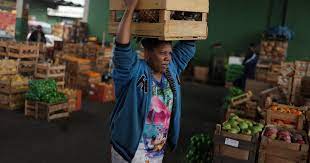Elisabetta Recine
The global hunger crisis is flashing red on all fronts, exacerbated by the fallout of the COVID-19 pandemic, climate change, and the war in Ukraine. The United Nations confirms global progress on hunger is lethally in reverse – with the Food and Agriculture Organization registering the worst numbers of food insecurity in eight years, and the global goal of ending hunger by 2030 appearing beyond reach.
Food prices are stuck at historic highs and low-income countries face an intensifying debt crisis. The Black Sea Grain Initiative, which was supposed to ensure Ukrainian grain exports could depart from the country’s Black Sea ports, has collapsed, thus eliminating a lifeline for poor food-importing countries. International summits have come and gone with a dearth of ideas or action on hunger. Brazil, an agricultural superpower and the world’s largest net exporter of food, has also seen hunger and poverty rise in recent years, after the administration of Jair Bolsonaro dismantled social policies, amid an economic downturn. Heartbreakingly, almost three in every five households do not always have enough to eat, while 33 million people (about 15 percent of the population) are going hungry.
But now President Luiz Inácio Lula da Silva, who was inaugurated in January, has stepped up. “I am obsessed with fighting hunger … I want workers to once again be able to have three meals a day in a dignified manner and to provide quality food for their children,” he said as he launched the Brasil Sem Fome (Brazil Without Hunger) plan in late August. Arguably the most comprehensive set of anti-hunger policies the world has ever seen, this bold plan opens a new front in the global war on hunger, just as hope was beginning to fade.
The Brasil Sem Fome – on which the National Food and Nutrition Security Council (CONSEA), the organisation I chair, advised – has far-reaching but simple goals. It aims to wipe Brazil off the UN Hunger Map by 2030 – no ifs or buts – and to ensure that more than 95 percent of households are food secure by the end of the decade. It also aims to improve access to healthy diets and kick-start a transition to sustainable agriculture. Some 32 programmes and policies will be leveraged to achieve these goals – from cash transfers to poor households to the purchase of healthy school food from smallholder farmers; from agroecological transition payments to support for Black and rural women, to bolstering protection of the Amazon. All of this will come under an apparatus that is purpose-built to bring the voices of food-insecure and marginalised people into the decision-making process.
If this plan sounds familiar, that is because it is a recast of the Fome Zero (Zero Hunger) policies introduced by Lula’s first administration in 2003 – but with an extra dose of ambition on democratic governance and sustainably produced food, reaching the most marginalised groups. That original policy halved food insecurity in Brazil and took the country off the UN’s Hunger Map – making Brazil a poster child for international development. By linking cash transfers to school attendance and healthcare, leveraging government purchases to support smallholders, and, crucially, building inclusive decision-making bodies, Lula’s government succeeded where many had failed. But the subsequent demolition of Brazil’s anti-hunger apparatus was just as dramatic. After coming to power in 2019, Bolsonaro’s far-right government imposed grinding austerity and dismantled the foundations of food and nutrition security policies. Brazilians found themselves without a safety net, just as the country was hit by the COVID pandemic. This teaches us a key lesson: it is possible to significantly reduce poverty and hunger indicators, but if we do not shift the structural determinants of inequalities, the results are easily and quickly undone. This time, the legacy must be longer-lasting and deeper.
This requires the plan to go even further in rolling out concrete actions to address the root causes of hunger – inequality and injustice. That means enabling access to land for the landless, fairer distribution of incomes, and confronting pervasive gender inequality and racism. There is also a need for deep participation, mobilisation and dialogue with Brazilian civil society. The promise of coordinated implementation across every ministry, and every level of local, regional and federal government will be key. Hunger is not homogeneous; it does not express itself uniformly. Really, we should talk of many hungers: hunger in the city, in the countryside, of children, of women, of Black and Indigenous peoples, etc. It is too big to tackle with just one programme or fragmented government department. But if Brazil is able to follow through on these comprehensive policies and beat back hunger again, the significance will resonate far beyond our borders. In the struggle against hunger, the world is in drastic need of answers. This plan could be a shot of hope and a highly significant global role model. Many hurdles remain, but Brazil is back, and the fight against world hunger is back on.







